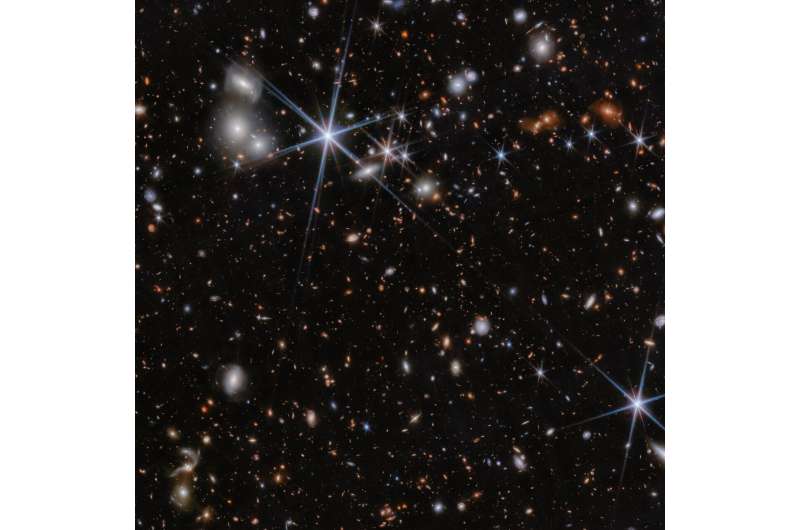This article has been reviewed according to Science X's editorial process and policies. Editors have highlighted the following attributes while ensuring the content's credibility:
fact-checked
peer-reviewed publication
proofread
Webb detects most distant black hole merger to date

An international team of astronomers have used the NASA/ESA/CSA James Webb Space Telescope to find evidence for an ongoing merger of two galaxies and their massive black holes when the universe was only 740 million years old. This marks the most distant detection of a black hole merger ever obtained and the first time that this phenomenon has been detected so early in the universe.
Astronomers have found supermassive black holes with masses of millions to billions times that of the sun in most massive galaxies in the local universe, including in our Milky Way galaxy. These black holes have likely had a major impact on the evolution of the galaxies they reside in. However, scientists still don't fully understand how these objects grew to become so massive.
The finding of gargantuan black holes already in place in the first billion years after the Big Bang indicates that such growth must have happened very rapidly, and very early. Now, the James Webb Space Telescope is shedding new light on the growth of black holes in the early universe.
The new Webb observations have provided evidence for an ongoing merger of two galaxies and their massive black holes when the universe was just 740 million years old. The system is known as ZS7. The study is published in the Monthly Notices of the Royal Astronomical Society.
Massive black holes that are actively accreting matter have distinctive spectrographic features that allow astronomers to identify them. For very distant galaxies, like those in this study, these signatures are inaccessible from the ground and can only be seen with Webb.
"We found evidence for very dense gas with fast motions in the vicinity of the black hole, as well as hot and highly ionized gas illuminated by the energetic radiation typically produced by black holes in their accretion episodes," explained lead author Hannah Übler of the University of Cambridge in the U.K. "Thanks to the unprecedented sharpness of its imaging capabilities, Webb also allowed our team to spatially separate the two black holes."
The team found that one of the two black holes has a mass that is 50 million times the mass of the sun. "The mass of the other black hole is likely similar, although it is much harder to measure because this second black hole is buried in dense gas," explained team member Roberto Maiolino of the university of Cambridge and University College London in the United Kingdom.
"Our findings suggest that merging is an important route through which black holes can rapidly grow, even at cosmic dawn," explained Übler. "Together with other Webb findings of active, massive black holes in the distant universe, our results also show that massive black holes have been shaping the evolution of galaxies from the very beginning."
"The stellar mass of the system we studied is similar to that of our neighbor the Large Magellanic Cloud," shared team member Pablo G. Pérez-González of the Centro de Astrobiología (CAB), CSIC/INTA, in Spain. "We can try to imagine how the evolution of merging galaxies could be affected if each galaxy had one supermassive black hole as large or larger than the one we have in the Milky Way."

The team also notes that once the two black holes merge, they will also generate gravitational waves. Events like this will be detectable with the next generation of gravitational wave observatories, such as the upcoming Laser Interferometer Space Antenna (LISA) mission, which was recently approved by the European Space Agency and will be the first space-based observatory dedicated to studying gravitational waves.
"Webb's results are telling us that lighter systems detectable by LISA should be far more frequent than previously assumed," said LISA Lead Project Scientist Nora Luetzgendorf of the European Space Agency in the Netherlands. "It will most likely make us adjust our models for LISA rates in this mass range. This is just the tip of the iceberg."
This discovery was from observations made as part of the Galaxy Assembly with NIRSpec Integral Field Spectroscopy program. The team has recently been awarded a new Large Program in Webb's Cycle 3 of observations, to study in detail the relationship between massive black holes and their host galaxies in the first billion years.
An important component of this program will be to systematically search for and characterize black hole mergers. This effort will determine the rate at which black hole merging occurs at early cosmic epochs and will assess the role of merging in the early growth of black holes and the rate at which gravitational waves are produced from the dawn of time.
More information: Hannah Übler et al, GA-NIFS: JWST discovers an offset AGN 740 million years after the big bang, Monthly Notices of the Royal Astronomical Society (2024). DOI: 10.1093/mnras/stae943
Journal information: Monthly Notices of the Royal Astronomical Society
Provided by ESA/Hubble Information Centre





















